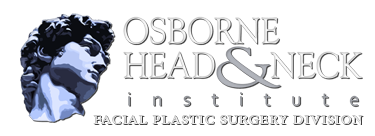Mohs micrographic surgery is a procedure used to remove skin cancer with precision, thoroughness and success. This procedure removes not only the tumor on the surface of the skin, but any roots below the skin as well. This ensures a complete removal of the tumor and helps prevent skin cancer from recurring.
Despite its high level of efficiency, Mohs surgery often leaves behind large wounds or scars in prominent areas such as the face or hand. These deformities can be emotionally upsetting and a constant reminder of the skin cancer that once existed there. Fortunately, plastic surgery can be performed to repair the wound and restore your skin to a more healthy and natural appearance.
Reconstruction after Mohs surgery at Osborne Head & Neck Institute can often be performed the same day or the day after the removal procedure. Reconstructive procedures are performed on an individualized basis, depending on each patient’s wound, and can involve a skin graft, flap of skin, stitching or surgical closure.
While complete tumor resection is the main goal, your doctor also takes your appearance into consideration by leaving as much healthy tissue as possible. Reconstruction uses this remaining healthy tissue to carefully restore the area for both effective and aesthetic results.
Facial Reanimation
Facial reanimation is one of many procedures used to treat facial paralysis and help patients regain control of their muscles for both functional and cosmetic purposes. Facial paralysis is often the result of a congenital defect, tumor, injury, surgery or disease. This can lead to asymmetrical facial expressions and problems with chewing, drinking, breathing and speaking. Facial paralysis also causes an inability to smile and drooping facial features, which often accompanies humiliation, low self-esteem and other distressing emotional side effects.
Performed in our Los Angeles or Beverly Hills surgical center, facial reanimation aims to restore symmetry and function to the facial nerve while maintaining the most natural look possible. The procedure utilizes several different techniques to restore facial movement based on each individual case. After a consultation with the doctor to assess your condition through physical examination, imaging tests and photographs, a customized surgical procedure is designed.
Reanimation is often performed through a series of different procedures spaced appropriately apart. A nerve graft taken from the leg can be inserted and wired to the five different branches of the facial nerve in order to replace the paralyzed nerve. After a certain amount of time to allow the nerve to reinnervate, a muscle graft is inserted and attached to the new nerve. After another period of waiting time, this muscle can be controlled by the nerve and facial movement can be restored.
Functioning results of facial reanimation can often be seen about six months after the second stage of the procedure is complete, with full results taking up to a year. This procedure cannot often restore perfect symmetry to a face, but can restore a functional degree of movement to improve the patient’s quality of life.
MEET our doctors. IN-OFFICE & VIDEO
APPOINTMENTS AVAILABLE
